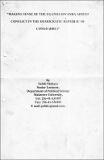| dc.description.abstract | At the time Rwanda and Uganda helped President Laurent Kabila come to power in the DRC (then Zaire) in May 1997, any critical observer would have anticipated that Uganda and Rwanda had become formidable allies. And no one, at that time doubted that a big regional force of these two allies had emerged, which force was strong enough to reckon with. It seems, it is the realisation of the existence of this force that prompted the Southern African allies, namely Zimbabwe, Namibia, Angola and others to join the war v the DRC on the side of Kabila. In the minds of the Southern Africa allies, the alliance between Uganda and Rwanda was poised to play a dominant role in the DRC- the third largest country on the African continent, rich in minerals and natural resources and geographically (and strategically) centred in the heart of the Africa. | en_GB |


